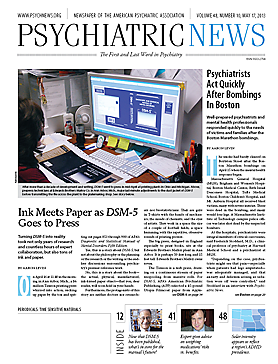The DSM-5 is a “living document,” not cast in stone, but with an entire section of the manual containing diagnostic material that looks to the future.
The formal diagnoses agreed upon by the DSM-5 Task Force, work group members, and the APA Board of Trustees—after more than a decade of work—are contained in Section II of the new manual, published this month. But Section III, titled “Emerging Measures and Models,” should be of equal importance to clinicians, because there they will find diagnostic tools that can be used today and also anticipate an evolving understanding of psychiatric illness tomorrow.
In an interview with Psychiatric News, DSM-5 Task Force Chair David Kupfer, M.D., emphasized that Section III should not be thought of as analogous to the appendix of DSM-IV—indeed, the new manual has an appendix that contains such material as a glossary of terms, along with the names and identifications of every individual who participated in the development of the manual.
Rather, Section III of DSM-5 contains some diagnostic categories that require further research and/or more time for clinicians to become acquainted with before being included in Section II, as well as usable tools that should enhance diagnosis of the conditions listed in Section II. The latter includes patient-rated and clinician-rated measures of symptoms that cut across all DSM diagnoses, measures of disability, information about how cultural context can influence the presentation of mental illnesses, and an alternative model for diagnosis of personality disorders.
“Section III is not a dumping ground for material that doesn’t belong in Section II,” Kupfer told Psychiatric News. “What we are trying to do here is provide tools and techniques that can enhance the clinical decision-making process. We think this material can help psychiatrists and other mental health professionals include patients in their own diagnostic assessment and better understand how culture shapes the presentation of disorders. And it includes some diagnoses that we hope will attract further research.
“Section III is quintessentially the section from which an evolving DSM of the future can grow,” Kupfer said. “And it is really what we are talking about when we say that the manual is a ‘living document.’ We won’t have to wait 20 or 25 years to have a new version or parts of a new version of the manual.”
Electronic Records Aid Use of Tools
The multiaxial system of earlier editions of DSM has been eliminated. Section I gives an introduction to DSM-5 with instructions on how to use the updated manual, and Section II outlines the categorical diagnoses.
In an interview earlier this year with Psychiatric News, Kupfer outlined some of the conceptual ideas that have informed the development of diagnostic criteria and the organization of the text. These include an appreciation of cultural factors in mental illness, a developmental approach to psychiatric disorders, a move toward the use of dimensional measures to rate severity and disaggregate symptoms that tend to occur across multiple disorders, and integration of genetic and neurobiological findings by grouping clusters of disorders that share genetic or neurobiological substrates (Psychiatric News, January 18).
Section III furthers those goals by moving toward a time when those genetic and neurobiological findings may make the current categorical schema less important, recognizing instead common symptoms that occur across all disorders and the varying ways in which individual patients may present.
Kupfer said that field trials of the DSM-5 criteria showed the utility of patient-rated cross-cutting symptom measures—an assessment tool that can be used to have patients rate the presence and severity of symptoms that occur in many disorders. The assessment tool, and others in Section III, will be especially useful to clinicians using electronic health records (EHRs); the questionnaire includes drop-down boxes for more specific information that patients can provide.
Similarly, Section III includes the World Health Organization’s Disability Assessment Schedule, reflecting a goal of the task force to include measures of impairment and disability. This tool, like the cross-cutting symptom measures, is especially amenable to use with EHRs.
“We do provide information about these tools in the text of the manual, but given the length of some of these tools, we are encouraging clinicians who want to ‘drill down’ to get more specific information to go electronic,” Kupfer said.
The material on cultural factors affecting presentation of mental illness was developed by the Study Group on Gender and Cross-Cultural Issues, chaired by Kimberly Yonkers, M.D. Kupfer said he believes the information there will be enormously useful to clinicians today and is likely to be incorporated into Section II in future editions of the manual.
Additional Diagnoses Described
The section also includes eight other diagnoses that were not included in Section II either because they require more research or more exposure to clinical experience to determine their usefulness. These are attenuated psychosis syndrome, depressive episodes with short-duration hypomania, persistent complex bereavement disorder, caffeine use disorder, Internet gaming disorder, neurobehavioral disorder due to prenatal alcohol exposure (ND-PAE), suicidal behavior disorder, and nonsuicidal self-injury.
Attenuated psychosis syndrome was one of the more controversial categories the task force considered. While not accepted for inclusion in Section II, the syndrome—which describes patients who experience distress and impairment from symptoms that do not rise to the clinical threshold of psychosis—points the way toward what many in psychosis research believe is the future: early identification and treatment of individuals before they become actively psychotic.
Finally, Section III also includes an alternative model for diagnosis of personality disorders. Criteria for these disorders in Section II are virtually unchanged from DSM-IV, but the alternative model points to a future that moves beyond the categorical diagnostic system of discrete disorders in DSM-IV toward a more dimensional system (Psychiatric News, May 3).
“We hope clinicians will actively use Section III, and we believe that it can help to push the field toward a system of diagnosis that more perfectly matches criteria to the individual patient in the clinician’s office,” Kupfer said. ■
Additional information is posted at
http://www.psychiatry.org/dsm5, including fact sheets on integrated assessment, cultural concepts, Internet gaming disorder, and Section III; and video clips on the following topics: Why are disorders included in Section III of
DSM-5 Why is caffeine use disorder included in Section III? Why is Internet gaming disorder included in Section III? What is the alternative model for diagnosing personality disorders?

